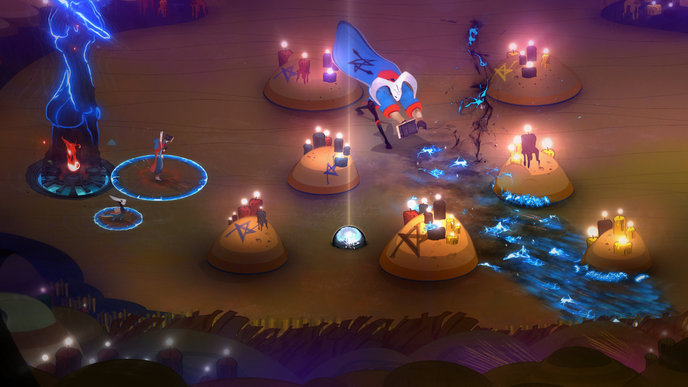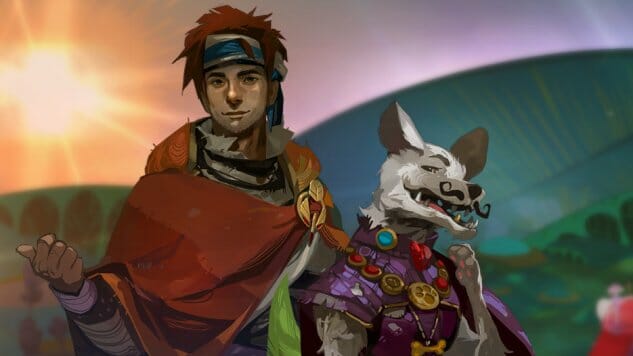With Pyre Supergiant Games, the studio behind 2011’s Bastion and 2014’s Transistor, seems to play with the central conflict of Ray Bradbury’s Fahrenheit 451. Citizens of the game’s Commonwealth who participate in forbidden acts are eternally exiled. Pyre tells the tale of the exiled looking for redemption, a way out of everlasting banishment. While it has the capacity to tell a heartwarming—or heart-wrenching, depending on your point of view—story, it flounders in both setup and progression. Compounded by the game’s obtuse design decisions and prolonged length, Pyre is a slog, a long and regrettably boring story about betrayal and deceit, banality and greed.
In order to be freed from exile in the Downside, a downtrodden part of the world where the inexorable and unrepentant reside, these dwellers have to battle in Rites, competitions in which two teams of three face each other and score points by throwing an orb into the other’s fire until it is reduced to ash. (It’s a rendition of soccer, but your freedom is on the line.) After partaking in enough Rites, you are given the chance to compete in a Liberation Rite, the same as a normal Rite, but the first character chosen regains their dignity, their freedom, their honor. It is here, in these competitions, that the game’s mechanics and systems are displayed.
These Rites are the core of Pyre. You assemble your triumvirate from a cast of characters you meet throughout the game’s approximately 15-hour narrative. These characters, as you’d imagine, fit into various classes, each replete with their own abilities, move sets and stats. Unfortunately, not every class is created equal: The Sap, a talking, walking, tree-like person, is amongst the worst, with abilities and moves both unexplained and impracticable during competition. (Not to mention that, next to the Demon, a tall, hulking, horned human, Saps are almost unmanageably slow.) This imbalance fosters situations where these characters remain the last picked—if ever picked—for the dodge ball team, meaning they gain little experience because they are seldom chosen for the Rites. And because you can only have three combatants at a time, and each Liberation Rite relinquishes the first one you select, by the time the game wraps up, you’re more than likely to be stuck with the worst classes available, making Rites far more tedious than they already can be.

Since Pyre seems so focused on classes, it’s safe to assume that the perfect trio would be more likely to lead you to victory than your favorite characters. (Think the Miami Heat’s former Big Three: Chris Bosh, Dwyane Wade and LeBron James.) This is true, to an extent: Because some classes are far superior to others, you’ll win every match by simply picking the most adroit classes in the game. (I won every match by selecting my Big Three: Hedwyn, Rukey and Sir Gilman.) And unsurprisingly, your choice of character, ultimately, doesn’t matter, for the AI is too hapless and mercurial: Some matches they are cunning and proficient; others they are bumbling buffoons, staring at you blankly while you plunge into the fire behind them as if to excitedly say, “Oh, wow, you’re so cool!”
Much like Supergiant’s previous games, Pyre’s controls are fluid and satisfying. When playing a Crone (serpentine witches) or a Demon you can feel their heft as they deliberately and slowly lumber about the stage, stalking both the adversaries and the orb. The same can be said when playing the Harp or the Imp: You can sense the gravity as the air gracefully whisks them while flying. It is a shame, then, that while you face many factions, the multitude of characters within the classes all feel functionally the same and operate as mere palate swaps. The potential for variance between the factions could’ve been a chance to diversify the monotony of this class-based system, but, instead, it only heightens it, making it seem more of a contrived implementation to extend both the narrative’s roster and runtime.
While 15 hours doesn’t sound inexcusably long, the game’s length seems far longer than the supposed runtime because of frequent, almost-nonsensical interruptions to explore this craven or sense this spirit or visit this grave. Pyre’s narrative focuses on you, the Reader—a faux-celestial human who can connect to the words written within the Book of Rites. You are the leader of the Nightwings—a faction infinitely favored by the Eight Scribes, god-like beings responsible for the millennia-long tradition. It is up to you to lead the Nightwings to victory, and liberate those exiled and the denizens of the Commonwealth of the Rites. The premise will introduce choices both decisive and tough, and this pseudo-autonomy can have drastic effects during the latter portion of the game. (For example, choosing whom to absolve after each Liberation Rite leaves a lingering, acerbic taste as you can only nominate those with enough experience.) Unfortunately, it is the in-between moments, the portions of downtime that pad out and otherwise disrupt the flow of the game. Getting from one Rite to the next is a chore, as you’re usually given a split path, each with a banal consequence that has little weight to the overarching narrative. This binary does nothing more than keep you from experiencing the core gameplay loop, and while it is commendable that there is a lull before the flames of competition, the lull is far too boring to be a respite from the scorching fire.
And thus Pyre is the purest definition of wasted potential. Even though the narrative has the capacity to be exciting and riveting, the plot twist is incessantly alluded to, then delivered far too late for it to be even the slightest bit meaningful or impactful. Supergiant knows game mechanics and controlling combatants during the Rites is rewarding and thrilling; it’s disappointing that the core gameplay loop is the best aspect of the entirety of the game. At a certain point, you enter a sort of autopilot, only playing in order to get to the next Rite. In Pyre, you’ll see yourself making it through to the end only to realize that you’re trying to extinguish an already diminishing flame.
Pyre was developed and published by Supergiant Games. Our review is based on the PC version. It is also available for PlayStation 4.
Jeremy Winslow is a Californian critic and essayist with big glasses who furiously types into WordPress and yells into the ether. He’s written for Feminist Frequency, GameSpot and more, and co-launched the small entertainment website Ground Punch. Listen to him yell on Twitter. Or don’t. That’s fine.

